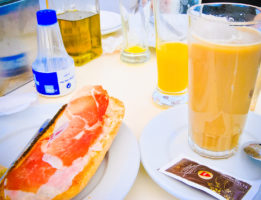By Christine Medina
As it so often does in Spain, the topic of food entered a recent conversation between friends. “How do you define Spanish food?” one of my friends posed to the group. My mind began flashing words like “simple”, “fresh”, “diverse”, and “imaginative,” but I knew in truth that Spanish cuisine isn’t so easily pegged down to a few colorful adjectives. In fact, it would be nearly impossible to define the complexity and sophistication that is Spanish cuisine — from simple dishes prepared in the home, to inventive, posh cuisine created by world-renown chefs.
If you can’t afford to experience the art that is food from the daring, highly-acclaimed chefs of Basque Country and Catalonia, or simply aren’t fortunate enough to gain entry to a Spanish mother’s kitchen, there is an essential Spanish dining experience you simply can’t miss: the venta.
Ventas (which come from the Spanish word of vender: to sell) are simple roadside eateries offering weary truck-drivers and travelers a place to fill their bellies. Historically, they arose from a need of affordable food for migrant workers in rural Andalusia, but today they’re no frills, often family-run restaurants, dotting the highways of Spain frequented by travelers and families (particularly on the weekends).
There are a few things you can always expect from a venta:
Products are locally sourced, if not grown by the restaurant itself. Imagine fresh, sun-ripened tomatoes, locally made olive oil and loaves of crusty bread, baked right in the restaurant’s ovens. The simplicity of the food at ventas, coupled with their quality makes for an unforgettable meal.
Since ventas are almost always in agricultural areas, they have access to super-fresh produce, sourced by local farmers, or grown in their own gardens. If you think a home-cooked meal is good, can you imagine a homegrown one?
The portions are generous. Going to a venta is, in many ways, like having a Spanish mother invite you to a meal in her home. Spanish mothers have an affectionate reputation for serving up more than enough food to family members and guests alike. A trip to the venta won’t leave you hungry, and chances are, you will sweat a little trying to clear your plate. Portions are enough to feed two per plate at least, so your best bet is to go with a group, order a few different plates and share it, family-style.
The quality is high and the price is low. In a marriage of delicious food at a great price, (as if that couldn’t get more attractive), they tend to feature a menu heavily focused on the area’s specialties. It’s Andalusian cuisine as it was intended to be: hearty and simple.
My favorite venta? I’ll never tell. They’re better when they’re discovered on your own, or shared in secrecy — whispered amongst truck-drivers who know all of the best stops, and enjoyed between friends and families for a Sunday lunch. However, I will let you in on this; they say the best ventas are the ones with the most semi-trucks parked outside of it. So next time you’re driving on a highway in southern Spain, keep your eyes peeled for that “venta” sign and tally up the trucks outside of it.
Christine Medina is a freelance writer, aspiring photographer and wanderlust-stricken expat currently living in Andalusia, Spain. Upon graduating from The University of Washington with a BA in Communications and a BA in Social Science, she set off to Spain to immerse herself in a new culture and learn the Spanish language. She writes about expat life and all things Spain on her blog, http://www.christineinspain.
*For more on Spanish culture, check out our guide to Madrid.

